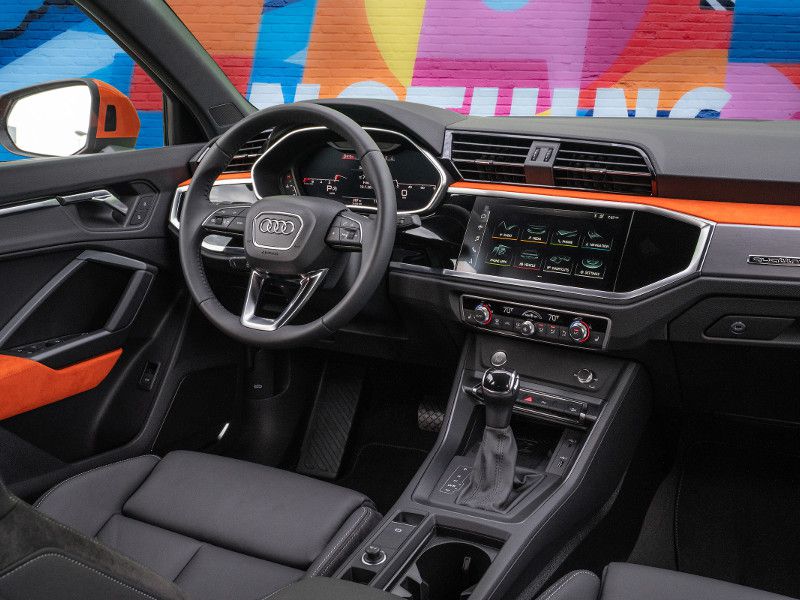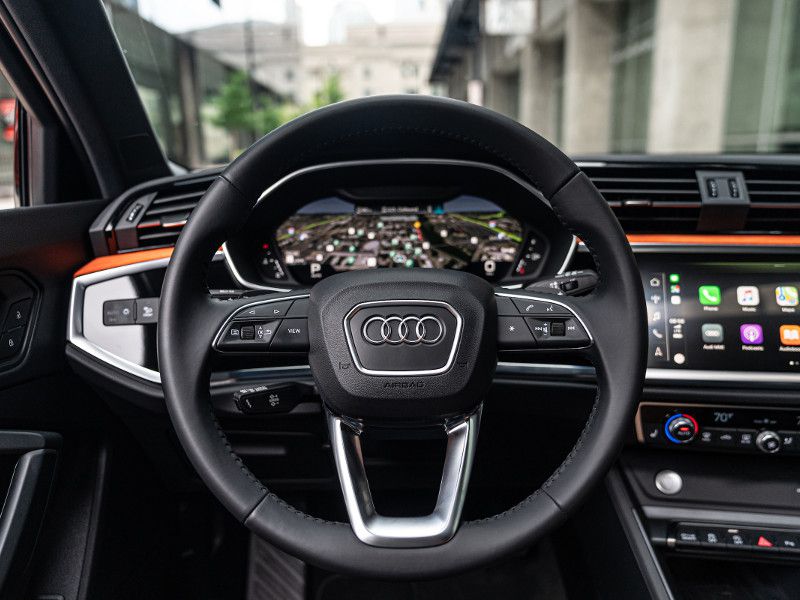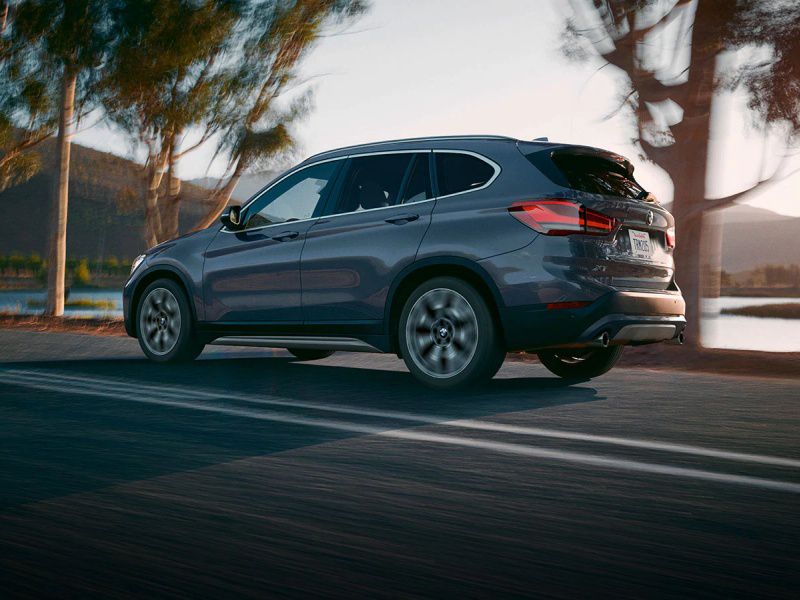Recent Articles
Popular Makes
Body Types
2022 BMW X1 vs. 2022 Audi Q3

2019 Audi Q3 ・ Photo by Audi
The BMW X1 and Audi Q3 share the same segment, but they approach it differently. Both vehicles are small five-passenger crossovers; both are the entry-level SUVs for their brands; and both leverage their brand’s strengths to gain traction in the hotly contested category. The X1 leans heavily on BMW driver’s car image while still offering significant interior and cargo space. The Q3 draws on Audi’s strengths — upscale exterior styling and excellent interior ergonomics. Both crossovers have turbocharged 4-cylinder engines, but while the BMW X1 offers a base front-drive version and an all-wheel-drive trim, the Audi Q3 is only available as a quattro with all-wheel drive. The Q3 and X1 are about the same size and have similar interior accommodations. Singles, couples, and even families with young children might find either right for them. Here is our comparison of the 2022 BMW X1 and 2022 Audi Q3.
Exterior design
When you look at the key dimensions of these two vehicles, you might begin to believe that BMW and Audi engineers worked in collaboration. The two SUVs are exactly the same height and have wheelbases that differ only by a fraction of an inch. The Audi is a little over an inch longer and wider than the X1. Basically the passengers in the two crossovers are riding in the same box. So the difference comes with branding. The X1 prominently displays the famous twin-kidney grille.The Q3 counters with its four rings inside the “single frame” grille. Overall the X1 presents a wedge-shaped theme while the Q3’s hood is flatter and its side windows smaller. The X1 also does a good job disguising its front-drive platform to resemble the larger, rear-drive BMW crossovers. The Q3 is a smaller version of a typical Audi crossover. The overall look is understated with restrained ornamentation.
: Tie

Photo by Audi
Interior Design
Audi has been winning praise for its interiors for more than a decade, and BMW has stepped up its interior-design game recently as well. The best aspect of the X1’s interior is its driver-focus. That’s not a surprising trait from the company that says it builds the "ultimate driving machine." The instrument panel is as straightforward as a small-town lawyer. Drivers get two big round gauges right in their lines of sight. The steering wheel is properly contoured and the controls on its spokes are large and easily identified. The front seats are supportive with 8-way power adjustments. In the back, sliding and reclining rear seats are optional and worth the added cost. Behind those seats is one of the largest cargo areas in the segment. The Audi Q3 has a very contemporary dash layout that integrates the infotainment screen better than the BMW does. The Q3 packs a lot of luxury into its small crossover. Standard features include panoramic sunroof, heated front seats, and leather upholstery. An available option package offers 8-way power front seats with memory for the driver’s seat, auto-dimming power-folding mirrors with memory, and a Homelink garage door opener. The top trim even offers a natural wood accent option.
: Audi Q3

Photo by Audi
Infotainment & Technology
Both the Audi Q3 and BMW X1 offer advanced infotainment systems, but the Q3’s system is a tad easier to use. The Q3 has the newest-generation MIB 3 infotainment system. An 8.8-inch touchscreen is the base unit while a 10.1-inch touchscreen is available on top trims. Apple CarPlay and Android Auto compatibility are standard. One unusual feature of the system is haptic feedback, and it enhances usability. The BMW X1 has an 8.8-inch display screen perched at the top of the dash. The iDrive infotainment system is controlled with a console-mounted rotary knob accompanied by buttons that enable users to access some functions directly. For first-timers, the Q3’s touchscreen-oriented system is easier to use. In the BMW Apple CarPlay compatibility is standard but Android Auto isn’t supported. At the same time, the iDrive system in the X1 has navigation and voice recognition. Wireless device charging is a standalone option. Looking at premium audio, the Q3 offers an optional 15-speaker, 680-watt Bang & Olufsen audio system. The BMW X1 makes a 12-speaker Harman Kardon system its premium audio choice.
: Audi Q3

Photo by Audi
Powertrains
The Audi Q3 and the BMW X1 keep their powertrain options fairly simple, and if you didn’t know better, you might think one brand’s copying off the other’s paper. The Audi Q3 offers the choice of a 184-horsepower and 228-horsepower versions of its 2.0-liter 4-cylinder engine backed by 8-speed Tiptronic automatic transmissions. The BMW X1 has a single engine offering — a 2.0-liter turbocharged 4-cylinder that is widely used in other BMW vehicles. Producing 228 horsepower and 258 lb-ft of torque, it has been tuned to deliver peak torque at low- and mid-range rpm. The front-drive sDrive 28i has an impressive 6.3-second zero-to-60-mph time while the all-wheel-drive xDrive 28i takes 0.3 seconds longer. With the 228-horsepower turbo four, the Audi Q3 scoots from 0-60 mph in 7.5 seconds. Like the Q3, both versions of the X1 offer 8-speed automatic transmissions. The performance-oriented BMW M Sport package includes a revised transmission and steering-wheel-mounted shift paddles.
: BMW X1

Photo by BMW
Driving Impressions
With the base 184-horsepower engine, the Audi Q3 cruises well and would be a good choice for those wishing to economize. Acceleration is more than adequate, and the ride quality is smoothly controlled. Most will have no complaints. That said, things get more exciting with the Audi Q3 S line Premium Plus 45 TFSI quattro and its 228-horsepower engine. The added horsepower doesn’t turn the Q3 into a performance car, but it does add to the driving enjoyment. BMW engineers have done their best to make the front-drive X1 feel like a rear-driver. But the xDrive all-wheel-drive system on xDrive28i offers technical trickery the sDrive28i can’t match. The AWD works with the electronic stability control to transfer power to the rear wheels when it is needed. This reduces understeer and improves traction on low-friction surfaces. For this reason, the slightly slower xDrive28i is more fun to drive on twisty roads and in poor weather.
: BMW X1

Photo by BMW
Safety & Driver Aids
The Q3 already had a good array of safety and driver-assistance features, and Audi has added some new safety features for the 2022 model year. Audi side assist with rear cross traffic alert and the Audi parking system plus are now standard equipment. Automated emergency braking with pedestrian detection and lane-departure warning are also standard across the Q3 lineup. For those who do a lot of interstate-highway driving, adaptive cruise control is available too. In the safety comparison, the BMW X1 goes toe-to-toe with the Audi Q3. The BMW Active Driving Assistant includes lane departure warning, frontal collision warning, pedestrian warning with automatic braking, low-speed collision mitigation with automatic braking, speed limit information, and automatic high beams. Real-time traffic information aids both safety and convenience. Another safety/convenience aid is adaptive cruise control with stop-and-go. It’s a standalone option on the X1.
: BMW X1

Photo by BMW
Interior Space & Cargo Carrying
Both the BMW X1 and the Audi Q3 are 5-passenger vehicles with substantial cargo space. That said, for cross-country journeys, four aboard is a more comfortable number. From some vantage points, the Audi Q3 looks bigger and boxier than the BMW X1, so it comes as a bit of surprise that the X1 has more cargo-carrying capacity. Behind the second row of seats, the BMW X1 has 27.1 cubic feet of cargo space, while the Q3 has 23.7 cubic feet. The X1 offers a voluminous 58.7 cubic feet of cargo space with the rear seats folded, and the Q3 offers a still impressive 48 cubic feet. Dimensionally, the X1 offers more rear-seat legroom, but in daily use, it is doubtful many passengers would notice a significant difference. Neither the BMW X1 nor the Audi Q3 are good choices for towing.
: BMW X1

Photo by BMW
Fuel Economy
In fuel economy, the BMW X1 tops the Audi Q3, although the difference isn’t stark. With its 228-horsepower 2.0-liter turbocharged engine, the front-drive X1 has EPA ratings of 24 mpg in the city and 33 mpg on the highway. The base Audi Q3 quattro has EPA ratings of 23 mpg city/30 mpg highway. The X1 xDrive28i has an EPA rating of 23 mpg city/31 mpg highway. The Q3 S Line quattro with the same horsepower rating as the X1 is rated at 21 mpg city/28 mpg highway. In normal driving, the typical customer is unlikely to sense a major difference between the fuel economy of the Q3 and X1.
: BMW X1

Photo by BMW
Pricing & Value
By this point, we are sure you have grasped that these two German-engineered luxury crossovers are very closely aligned in every major category. And that certainly includes price. The base BMW XC1 sDrive28i has a suggested list of $35,400 plus $995 destination charge. With the $2,000 surcharge for all-wheel-drive models, the xDrive28i has an MSRP of $37,400 plus the destination fee. The base Audi Q3 Premium 40 TSFI quattro has a base price of $36,400 plus the $1,195 destination charge. That’s more than the base X1 but less than the X1 with all-wheel drive. The Audi Q3 S line Premium Plus 45 TFSI quattro has a base price of $38,700 plus the destination charge. The two vehicles are certainly in the same pricing ballpark, but at least in terms of suggested prices, the BMW X1 has a slight edge.
: BMW X1

Photo by BMW
The Winner
While we compiled the stats for this comparison test, we noticed that on paper (or in pixels), the BMW X1 and Audi Q3 are very much alike. At the same time when we delved a bit deeper into the individual categories in this comparison, the X1 was able to squeeze out victories in six of the nine categories. The Audi Q3’s strong points are its attractive interior and exterior styling, advanced infotainment system, two engine choices, and standard all-wheel drive. On the other hand, the BMW X1 offers better acceleration and handling, more distinctive exterior styling, and the choice of front-wheel drive. Both vehicles will offer their drivers refined and sophisticated experiences, combining luxury with practicality. Choosing a clear winner is difficult, but our choice is the 2022 BMW X1.
: BMW X1

Photo by BMW